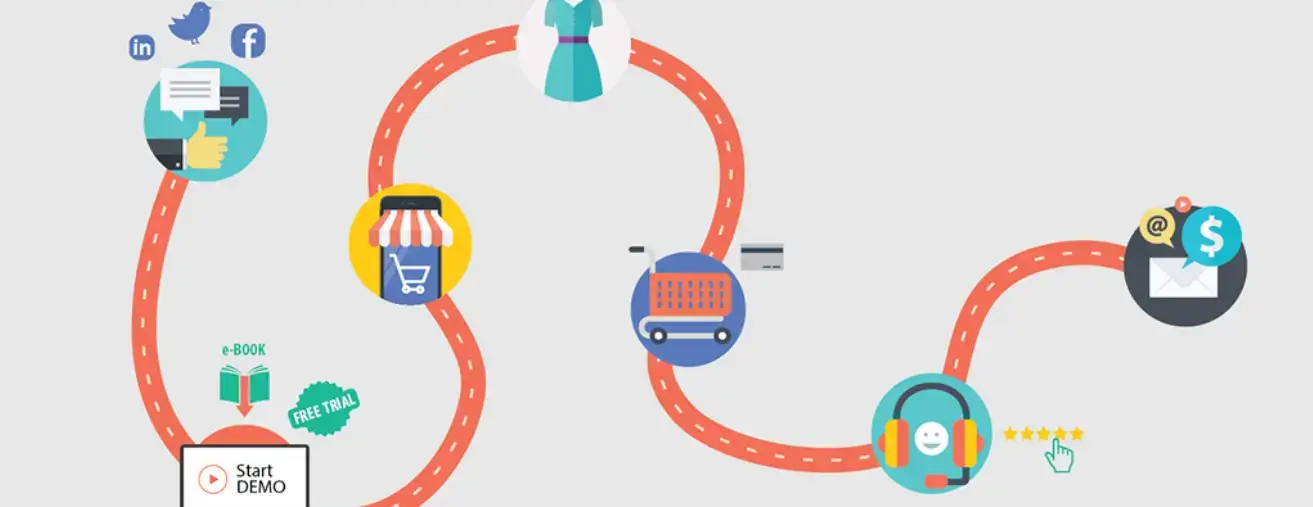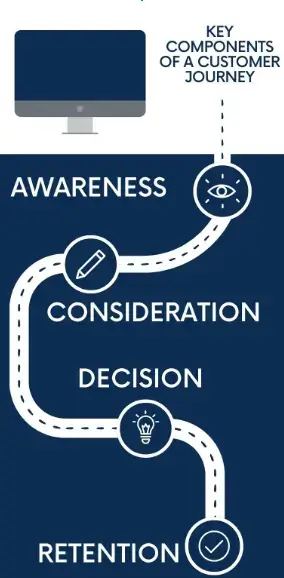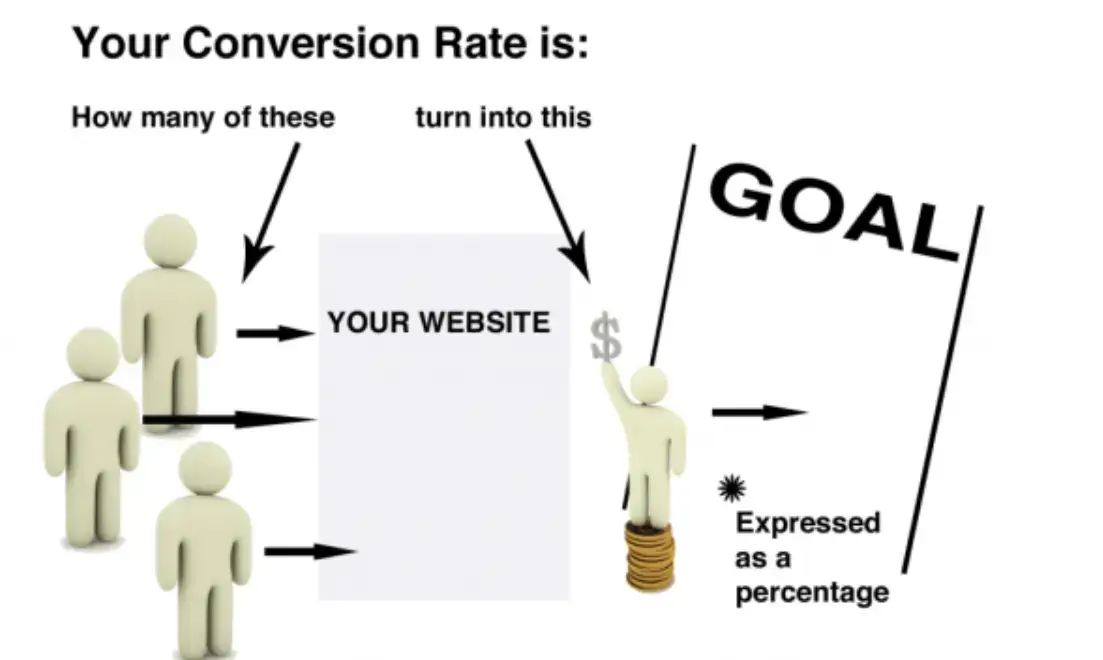Have you ever wondered how your customers find you—how they navigate from the first spark of interest to finally making a purchase?
Understanding this path is crucial, and that’s where a customer journey map comes into play.
It’s a tool that helps you visualize the entire process, capturing every touchpoint and emotion. It’s about putting yourself in your customer’s shoes and seeing your business through their eyes.
But what about social media? It’s more than just a place for friends and family; it’s also a vibrant marketplace where your customers spend significant time.
Skip to:
- Understanding Customer Journey Mapping
- Social Media as a Sales Channel
- Optimization Tools and Technologies

Have you considered using social media as a sales channel? It offers unique opportunities to connect, engage, and convert your audience into loyal customers.
This article will guide you through integrating social media into your customer journey map. You’ll discover how these two powerful tools can enhance your sales strategies.
Whether you’re a small business owner, a marketing professional, or simply curious about the subject, these insights are for you.
Understanding Customer Journey Mapping
Do you remember the last time you made a purchase online?
Think about the steps you took. Perhaps you saw an ad, read some reviews, visited a website, and finally clicked the “buy’ button.
The series of steps, emotions, and decisions is the customer journey unique to each person.
- What is a customer journey map?
A customer journey map is like a roadmap of your customers’ experiences with your brand.
Imagine it as a detailed guide showing what your customers think, feel, see, and do at each stage of their interaction with you.
It’s not just about the sale; it’s about understanding the entire process, from awareness to loyalty.
- Critical components of a customer journey

A customer journey typically consists of several stages:
- Awareness: When a customer first learns about your brand or product.
- Consideration: When they start comparing and thinking about whether to buy.
- Decision: When they choose to purchase.
- Retention: When they become loyal customers, returning for more.
Within these stages, specific touchpoints, emotions, and experiences shape their journey.
-
Benefits of mapping the customer journey
Why bother with all this mapping? The advantages are threefold:
- Personalization: By understanding your customers’ paths, you can tailor your offerings and communications to meet their needs.
- Optimization: It helps you identify areas where you can improve, whether in customer service, product features, or marketing strategies.
- Loyalty building: Knowing what keeps your customers returning allows you to foster long-term relationships and loyalty.
Mapping the customer journey isn’t just a task for big corporations; it’s a valuable tool for businesses of all sizes.
Whether selling products online or offering a local service, understanding your customers’ journey is crucial to your success.
Social media plays a pivotal role in shaping and enhancing the customer journey. You stand to gain much by leveraging this powerful channel to connect with your audience meaningfully.
Social Media as a Sales Channel
You’ve got the gist of a customer journey map and appreciate how social media can serve as a vibrant sales channel.
But how do the two intertwine? How can you integrate social media into different stages of the customer journey? Let’s break it down.
-
Awareness stage: Building brand awareness
Remember when you first heard about your favorite brand? Social media can be that initial spark.
You can introduce your brand, showcase your products, and start a conversation.
Eye-catching visuals, engaging posts, and targeted ads can make your audience stop scrolling and start noticing.
-
Consideration stage: Engaging and informing the audience
Now that they know you, what next? This stage is about nurturing interest.
Share informative viral content, answer questions, and encourage discussions on social platforms. Show your audience what sets you apart and why they should consider your product or service.
-
Decision stage: Converting prospects into customers
You’ve caught their attention, and they’re interested. It’s time to seal the deal. Use social media to offer exclusive discounts, highlight positive reviews, or provide a seamless checkout process.
Make it easy and appealing for them to say "yes." According to Lankitha Wimalarathna, CEO of Hiveage:
“The journey doesn’t end with a sale. Keep your customers engaged and loyal through consistent interaction on social media."
She continues, "Share updates, ask for feedback, and offer loyalty rewards. Make them feel valued and part of your brand’s community. Mapping social media into the customer journey is like adding a dynamic layer to your marketing and sales strategy."
"It’s about recognizing where your audience is and meeting them there, crafting messages that resonate at each stage, and turning casual interactions into meaningful relationships and sales.”
Optimization Tools and Technologies
Are you excited to implement these strategies in your business? With the right approach, social media can become a powerful extension of your customer journey, amplifying your reach and impact.
Having the right tools and technologies makes this job a lot easier.
Let’s explore some of them—and remember, these can all be part of your overall strategy using POWR.io website apps to streamline your sales social media funnel:
1. CRM software
Examples: Salesforce, HubSpot, Zoho CRM
How to Use: These platforms, equipped with various CRM Plugins, allow you to track customer interactions across social media and other channels. You can segment your audience, personalize content, and automate social media marketing campaigns. It’s all about connecting with your customers in a meaningful way.
2. Social media management tools
Examples: Hootsuite, Buffer, Sprout Social
How to Use: These tools can plan and schedule posts, track engagement, and analyze results effortlessly. They help you maintain a consistent presence on various platforms and understand what resonates with your audience.
3. Content creation tools
Examples: Canva, Adobe Spark, Snappa
How to Use: Visuals are crucial to standing out on social media. These tools make creating professional-looking graphics, videos, and animations easy without design skills. Capture attention and convey your brand message creatively.
4. E-Commerce integration tools
Examples: Shopify, WooCommerce, BigCommerce
How to Use: Want to sell directly on social media? These platforms allow you to shop on sites like Facebook and Instagram, offering a seamless buying experience. Turn browsers into buyers without them ever leaving the platform.
5. Analytics and monitoring tools
Examples: Google Analytics, Kissmetrics, Socialbakers
How to Use: Understanding your performance is crucial. These tools provide insights into how people interact with your social media content, where they are in the customer journey, and what’s driving sales. Make informed decisions and continually refine your strategy.
The beauty of these tools and technologies is that you can tailor them to fit your business regardless of size or industry.
Whether you’re starting to explore social media as a sales channel or looking to elevate your existing strategies, these tools can pave the way to success.
Conclusion
And there we have it! From understanding the intricate paths your customers take to integrating the bustling world of social media into their journey, you now have a roadmap to success.
Social media isn’t just a place to share and connect; it’s a powerful sales channel that brings your brand closer to the people who matter most—your customers.
The tools and strategies we’ve explored are more than just tactics; they’re about building relationships, understanding needs, and delivering value at every journey stage.
It’s a dynamic, responsive, and exciting way to engage with today’s consumers.
So, are you ready to take your customer journey to the next level? With social media at your side, you can transform casual interactions into lasting connections and sales.
Embrace the possibilities, experiment with the tools, and watch your business grow.



